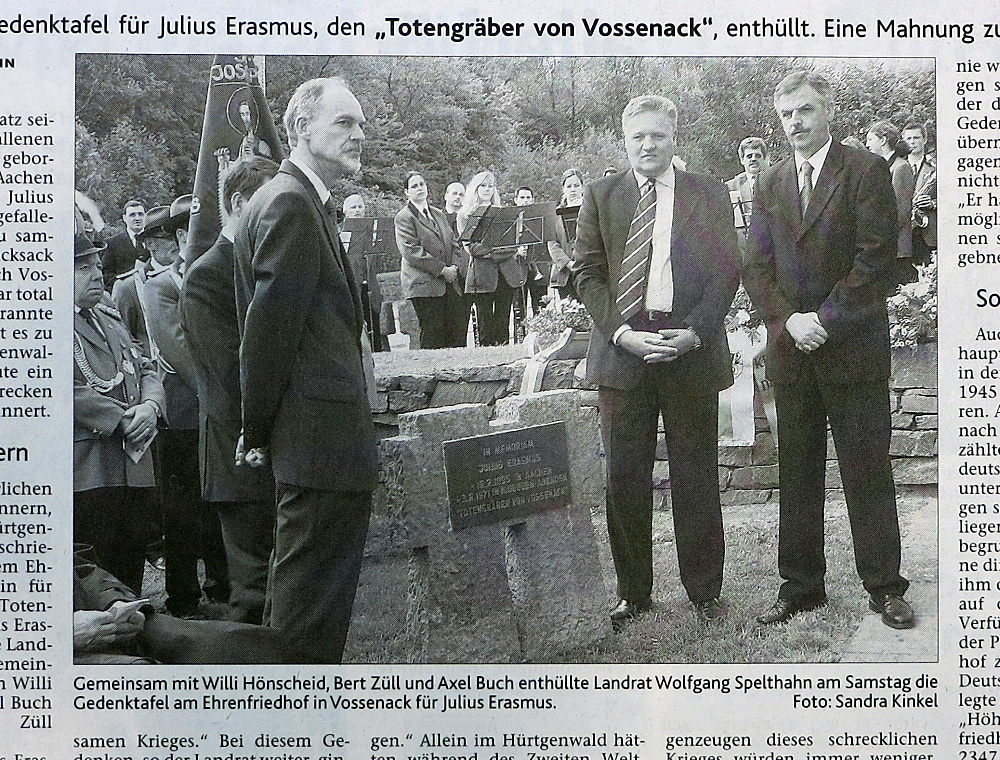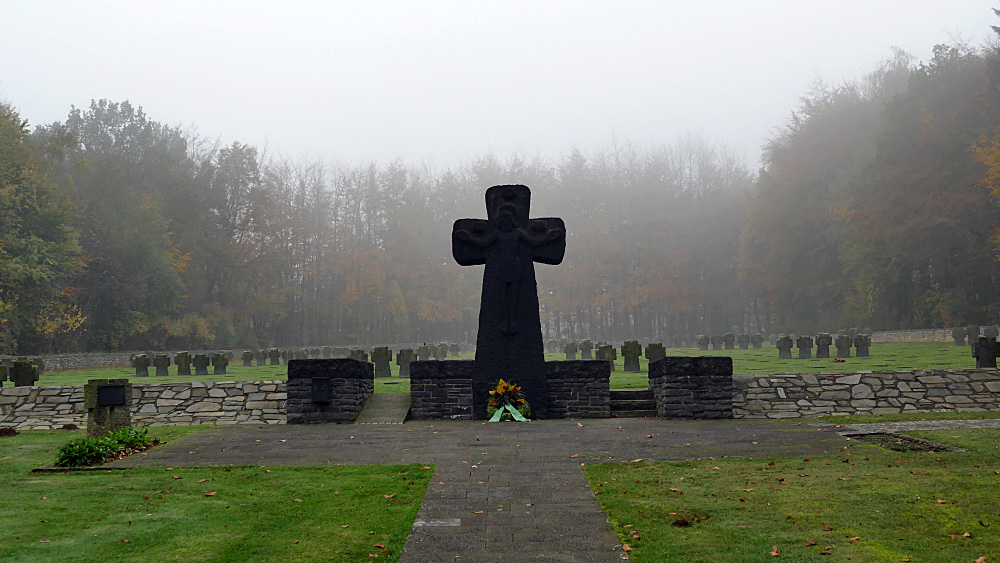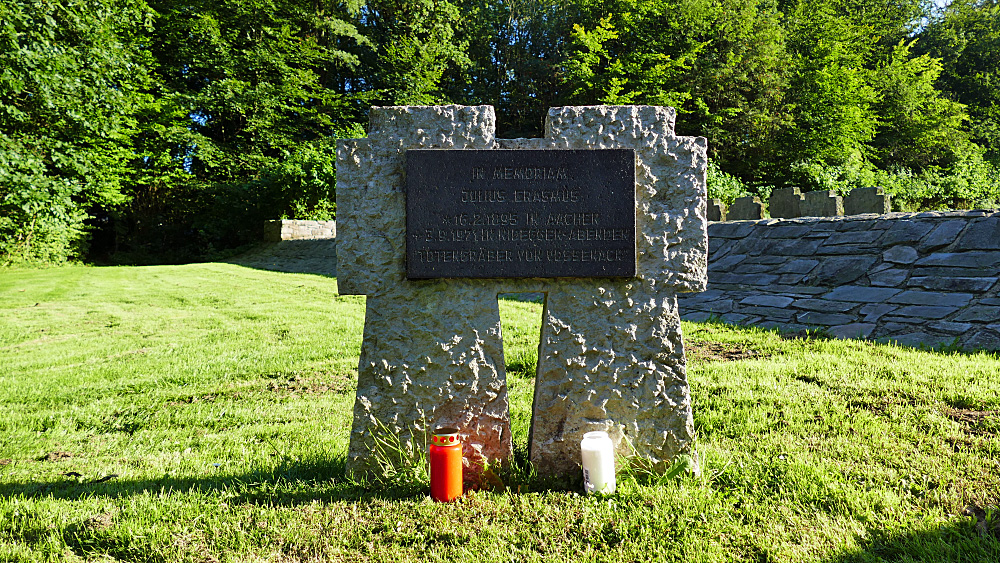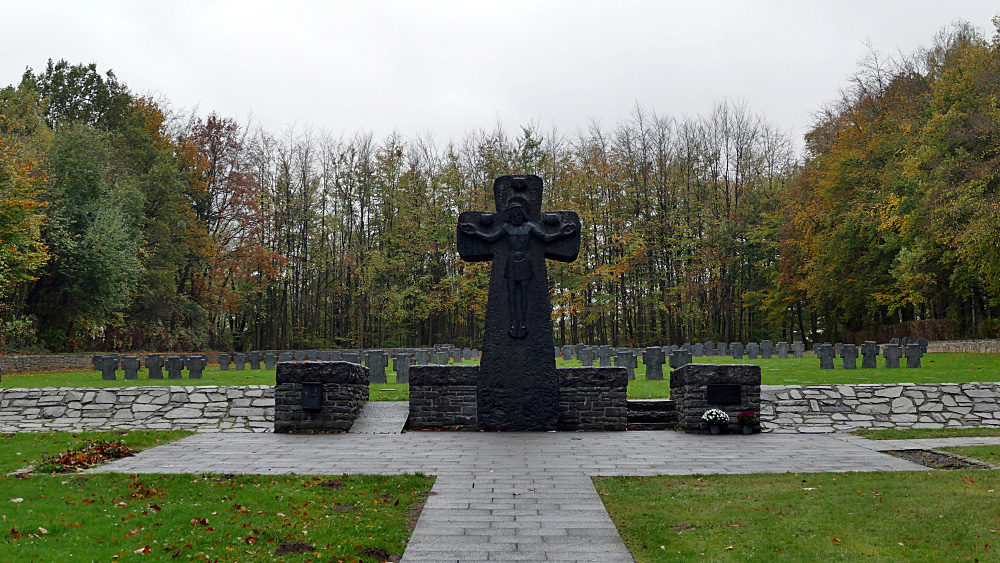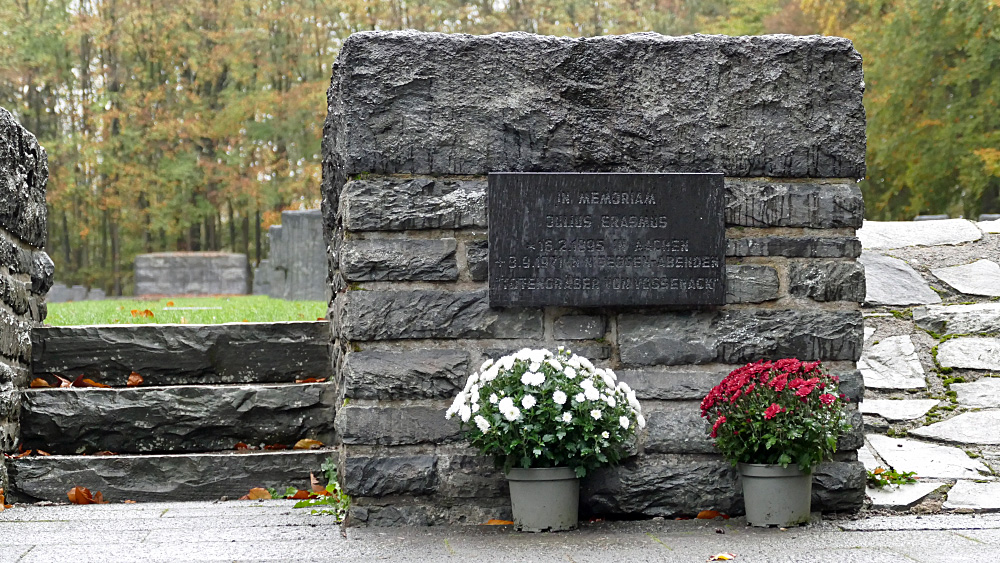“Modern culture of remembrance” in the District of Düren: The removal of the memorial stone for Julius Erasmus by the District in September 2022 (Published on 06/02/2024)
I. The “modern culture of remembrance” of the District of Düren
There have already been several reports on this blog about how the District of Düren under District Administrator Wolfgang Spelthahn (CDU [Conservative party]), who is responsible for the military cemeteries in Hürtgen and Vossenack, is putting its ideas of a supposedly “modern culture of remembrance” into practice. This presumably includes the ban imposed by the District administration on visitors to the cemeteries in question to place candles or flowers or photos of fallen soldiers in uniform there.
As is well known, in 2020 the District of Düren appointed its own „Beauftragten für die Betreuung der Kriegsgräberstätten Vossenack und Hürtgen als Orte einer demokratischen Erinnerungs- und Gedenkkultur“ (“representative for the care of the Vossenack and Hürtgen war cemeteries as sites of a democratic culture of remembrance and commemoration”, hereinafter “representative”), namely Frank Möller from Cologne, who is, among other things, described as a historian and an “expert in the culture of remembrance and the interpretation of the present” („Fachmann für Erinnerungskultur und Gegenwartsdeutung“). A report on the matter can be found here. Although the District of Düren is so reluctant to provide information about the background to this appointment, its details and the specific personnel involved that several court cases are pending, it nevertheless regularly takes up and implements the proposals of this “representative”.
The theses of the “representative” receive conspicuously benevolent and uncritical support from the local newspaper, the Dürener Zeitung, which in turn hardly takes dissenting voices into account. This has also already been reported on (cf. e.g. here and here).
II. The District of Düren and the memory of Julius Erasmus
For some time now, the District of Düren has distanced itself from remembering Julius Erasmus.
While back in the year 2005, District Administrator Spelthahn, who was already in office at that time, paid tribute to Julius Erasmus at a ceremony organized by Volksbund Deutsche Kriegsgräberfürsorge e.V. (“Volksbund”) and unveiled an information board and a memorial stone for him accompanied by warm words, the same District Administrator is now pushing for the removal of these memorials which he inaugurated.
At the time, Mr Spelthahn even acted as the “patron of the commemorative event” and – according to the corresponding report in Dürener Nachrichten of 24/05/2005 – spoke sentences such as (citations translated from German language):
“Today we thank Julius Erasmus for his life’s work in a very concrete way, but we also remember all the victims of this cruel war.” “In the Hürtgen Forest alone”, 70,000 soldiers had died during the Second World War. “They were all victims who were sent to a senseless death in the line of duty”, Mr Spelthahn is cited to have said at the time. And: “We need memorial stones like this one so that the memory does not die, so that war will never again break out from this ground.”
Some twenty years later, when most of the war and post-war generation has passed away, this is obviously no longer the case and Mr Spelthahn is propagating the eradication of this commemoration.
III. The removal of the information board on Julius Erasmus in 2021
It began with an article in Dürener Zeitung in January 2021, in which the aforementioned “representative”, who according to the author holds a “university degree in history, German and media studies”, attempted to portray Julius Erasmus as a kind of “war-torn egomaniac” in an interview, whereby his unscientific approach, in particular his very selective handling of sources, was particularly striking.
Nevertheless, the District of Düren took action immediately after the article appeared.
At the end of May/beginning of June 2021 – when exactly is “no longer known” according to them –they removed the information board about Julius Erasmus from the military cemetery in Vossenack. That the reasons given for this were as absurd as they were untrue did not bother him. The process was described in more detail here and here.
IV. The removal of the memorial stone for Julius Erasmus in September 2022
Most recently, in September 2022, the District of Düren also laid hands on the memorial stone for Julius Erasmus and removed it.
1. The memorial stone for Julius Erasmus
The memorial stone consisted of a stone cross, a so-called “double cross”, with a memorial plaque attached to it and the text
„In memoriam
Julius Erasmus
* 16.2.1895 Aachen
+ 3.9.1971 Nideggen-Abenden
‚Totengräber von Vossenack‘
[‚undertaker of Vossenack‘]“
The memorial plaque was separated from the “double cross” and attached to the wall surrounding the burial ground; the “double cross” was removed. This means that the memorial stone is also history, regardless of the – presumably anyhow only temporary – preservation of the memorial plaque.
The original location of the memorial stone and the current location of the memorial plaque can be seen in the following pictures:
2. Another “small step towards restructuring the culture of remembrance”
Here, too, the removal of the memorial was accompanied by the usual benevolent coverage in the local press. Dürener Zeitung reported the matter on 20/10/2022 under the title „Wieder wird ein Stein von der Kriegsgräberstätte entfernt“ (“Another stone is removed from the war cemetery”). The fact that the memorial stone as such had been removed was, of course, concealed and it was reported in abbreviated form that “the memorial plaque to Julius Erasmus” had been “given a new place”. A typical example of their suggestive reporting, in which the essential aspect – the removal of the memorial stone as such – is concealed, while giving the readership the impression that the memory of Julius Erasmus – which is only expressed in a “small memorial plaque” anyway and therefore has no great significance – is intended to be preserved (all citations translated from German language).
The article states (translation from German language):
“Frank Möller, the voluntary representative for the District of Düren’s war gravesites in Hürtgen and Vossenack, continues to take small steps to transform, the culture of remembrance in the community.
At his suggestion, the District of Düren, which is responsible for the war gravesites, has removed another bright double cross on which a small memorial plaque commemorated Julius Erasmus, who recovered dead soldiers from the woods after the war and was the cemetery caretaker for many years. However, the memorial plaque has not been removed: It was attached to the quarry stone wall surrounding the actual gravesite.”
The reason for the transfer was once again based on the theses of the aforementioned “representative”. He was said to have made the following comments in his unspecified “newsletter” (translation from German language):
“The double crosses did not belong on the Vossenack war gravesite. They were an invention of the landscape architect Karl Ludwig Schreiber, who developed them especially for the Hürtgen war gravesite and thus deliberately set himself apart from the design of the Vossenack war gravesite with its militaristic symbol crosses and its architect Robert Tischler.”
Those who find these theories unconvincing are not alone. However, they were enough for the District of Düren to remove the memorial stone.
3. Information from the District of Düren on the “relocation” of the memorial plaque
In October 2022, I asked the District of Düren for information on the “relocation” of the memorial plaque, including the circumstances underlying this, on the basis of the Freedom of Information Act of the state of North Rhine-Westphalia (“IFG NRW”). In an unusually detailed response, the District of Düren stated (translation from German language, emphasis added)
“The background to the relocation is as follows:
The memorial plaque for Julius Erasmus was installed at the Vossenack war gravesite in 2005. At that time, it was attached to a double cross, which was positioned to the left of the steps to the cemetery on a grassy area.
In 2021, the ‚Rheinische Kunststätten‘ series, published by the Rheinischer Verein für Denkmalpflege und Landschaftsschutz, published booklet no. 578 on ‚Die Kriegsgräberstätten Hürtgen und Vossenack in der Nordeifel‘. This was the first time that the contrasting architectural concepts in the development of the two war gravesites at Hürtgen and Vossenack were analyzed.
In this context, it became clear that the creator of the double crosses, the horticultural architect Carl Ludwig Schreiber, had deliberately distinguished himself from the form of the symbolic crosses with his so-called ‘comrade crosses’. The double crosses, designed by the horticultural architect Carl Ludwig Schreiber, were a deliberate departure from the symbolic crosses that can be found at the Vossenack war gravesite and were developed by the architect Robert Tischler. Carl Ludwig Schreiber had designed his double crosses exclusively for the Hürtgen war gravesite and would certainly not have agreed to their subsequent installation at the Vossenack cemetery.
After this recognition, the double cross on which the memorial plaque for Julius Erasmus was located was removed. The aim was not to erase the memory of Julius Erasmus. For this reason, the memorial plaque was permanently installed on the wall to the right of the narrow staircase that leads to the actual burial ground. This has the advantage that anyone interested in visiting the burial ground can pass by the plaque and read it immediately. At the previous location of the plaque, you could only read it if you turned left before entering the cemetery and headed straight for the double cross.”
It is probably no coincidence that the author of the aforementioned booklet no. 578 remains unmentioned: it is Mr. Möller, the so-called “representative”. The removal of the memorial stone is therefore based on the “recognition” that the District of Düren gained from the theses of its own “representative”.
The rest is the usual shallow, elementary school-level sermon, presumably written by the press office of the District administration, which had already denied the existence of the “flower ban” on the military cemeteries in Hürtgen and Vossenack. This is the background for the assertion that it was not intended “to erase” the memory of Julius Erasmus – an astonishing choice of words in itself! –, but that the relocation of the “memorial plaque” would even improve its perception, as it was no longer necessary to “turn left” and “head straight for” the memorial stone!
The Düren District administration as it lives and breathes.
4. The “double cross” as a “site-specific monument”?
Does the booklet no. 578 written by Mr Möller, on which the District of Düren bases the removal of the memorial stone, at least provide a comprehensible justification for this? Unfortunately not, because the explanations given there are incomprehensible already due to their technical deficits.
Although the 26-page, attractively designed booklet contains numerous assertions and quotations, these are not supported by source citations. At the end of the booklet there is a list of (allegedly) used “sources and literature”, but there is no concrete link between the statements made in the text and the respective source(s), so that it is not clear what was used at all and for what purpose. In any case, the alleged “analysis” of “architectural concepts” claimed by the Düren District cannot be found there in a form that at least meets minimum scientific requirements. This is all the more strange as the author – see above – is supposedly the holder of a “university degree in history, German and media studies”. Is he not familiar with the basics of academic working?
First of all, a “double cross” is not an “invention”, but a work of fine art that is subject to copyright. In substance, a thesis according to which the “double cross” may only be used at the military cemetery in Hürtgen and that the consent of Mr Schreiber (who died in 1976) was required for everything else is nonsense.
There is no evidence that the „double cross” – as the Düren District administration claims – was designed “exclusively for the Hürtgen war gravesite” and could not be used for any other purpose. Whether the long-deceased Mr Schreiber would agree with this today or not is nothing more than speculation, but is irrelevant anyhow. In any case, the “double cross” was designed at the time on behalf of and for Volksbund, which erected both the Hürtgen and Vossenack war cemeteries. Should no individual agreement on the use of the “double crosses” have been made with the latter, for which again nothing is apparent, it is basically up to Volksbund to decide on the use of the “double crosses”. In 2005, it decided to use one of these “double crosses” for affixing on it the memorial plaque to Julius Erasmus at the military cemetery in Vossenack. It is not clear how this could be objected.
If Volksbund is of a different opinion today – and this can undoubtedly be assumed – it should publicly announce this and remove the memorial stone; this would at least be consistent and honest.
5. The cost to the taxpayer of moving the memorial plaque
The question remains as to the costs of this charade for the taxpayer. The author of this article has also asked the District of Düren for information on this subject on the basis of the IFG NRW. The District of Düren put the cost of moving the plaque at EUR 955.26; two stonemasons spending a total of around 12 hours on the job.
A lot of effort for a “modern culture of remembrance” project, which from the outset is primarily reminiscent of an amateur drama. The District of Düren and District Administrator Spelthahn will hardly care, as the objective pursued was achieved. The memorial stone for Julius Erasmus no longer exists.
V. Assessment
The alleged need to remove the memorial stone did not exist.
Admittedly, a “double cross” is of course very different from the stone crosses used on the burial ground of the Vossenack cemetery. However, as the memorial stone for Julius Erasmus was located outside the burial ground, there was no optical stylistic disruption either.
As in the case of the removal of the information board on Julius Erasmus, the justification put forward by the District of Düren under District Administrator Spelthahn does not hold water here either. It seems that the alleged reason was – once again rather clumsily – fabricated to provide a pretext for removing the monument: A supposed “expert” – the so-called “representative”, the District’s own expert by virtue of his function – makes a “technical suggestion”, which the administration then puts into practice in supposed reliance on his supposed expertise. If the “technical suggestion” subsequently proves to be nonsense or is nonsense from the outset, a fait accompli has nevertheless been created and the objective achieved.
Of course, this has nothing to do with an earnest administration, but that does not seem to be a problem. Accordingly, the Düren District administration’s assertion that it would not seek “to erase the memory of Julius Erasmus” and that the memorial plaque has been “permanently installed” at its new location should be viewed with skepticism. It would not be surprising if this plaque were also to suddenly disappear; after all, the disappearance without a trace of unwelcome monuments overnight has become something of a tradition in the District of Düren.
(Head picture: Relocated memorial plaque for Julius Erasmus
at the German military cemetery Vossenack, July 2023)
Further articles on the topic “‘Modern culture of remembrance’ in the District of Düren”:
- The removal of the information board on Julius Erasmus from the Vossenack military cemetery in 2021 (03/10/2021)
- Volksbund Deutsche Kriegsgräberfürsorge NRW on the removal of the information board on Julius Erasmus from the Vossenack military cemetery in 2021 (17/06/2022)
- News on the removal of the information board on Julius Erasmus from the Vossenack military cemetery in 2021 (23/08/2022)
- The “representative for the care of the war grave sites Vossenack and Hürtgen as places of a democratic culture of remembrance and commemoration” (“Beauftragter für die Betreuung der Kriegsgräberstätten Vossenack und Hürtgen als Orte einer demokratischen Erinnerungs- und Gedenkkultur”) (16/11/2022)
- The ban on laying flowers and candles at the military cemeteries in Hürtgen and Vossenack (12/02/2023)
- Administrative Court Aachen denies grant of a preliminary order against the District of Düren “flower ban”, appeal to the Higher Administrative Court (23/03/2023)
- Laying of wreaths by the Administrator of the District of Düren at the Military Cemeteries in Hürtgen and Vossenack on Remembrance Day 2022 – or: Quod licet iovi, non licet bovi?(21/04/2023)
- District of Düren denies “flower ban” on Military Cemeteries in Hürtgen Forest to press and media (13/05/2023)
- “Flower ban” of the District of Düren on the Military Cemeteries in Hürtgen Forest: Higher Administrative Court of the State of North Rhine-Westphalia rejects the appeal against the denial of urgent legal protection (03/07/2023)
- Administration out of control – District now also bans photos of the fallen in uniform at Military Cemeteries in Hürtgen Forest (18/08/2023)
- The “permanent exhibition” on the Hürtgen war cemetery (20/12/2023)
- The distortion of remembrance on the national Remembrance Day (“Volkstrauertag”) (21/04/2024)
- The “Dance Theater” over the graves of the war dead at the military cemetery in Vossenack on the occasion of Remembrance Day (“Volkstrauertag”) 2023 (19/08/2024)
- The statement of the President of Volksbund Deutsche Kriegsgräberfürsorge e. V. on the “Dance Theater” at the military cemetery in Vossenack on the occasion of Remembrance Day 2023 – a “fact check” (13/11/2024)
- Information from the District administration on “incidents with a right-wing extremist background” at the military cemeteries in Hürtgen and Vossenack and on “violations” of the cemetery rules (13/03/2025)
If you wish to support my work, you can do so here. Many thanks!


